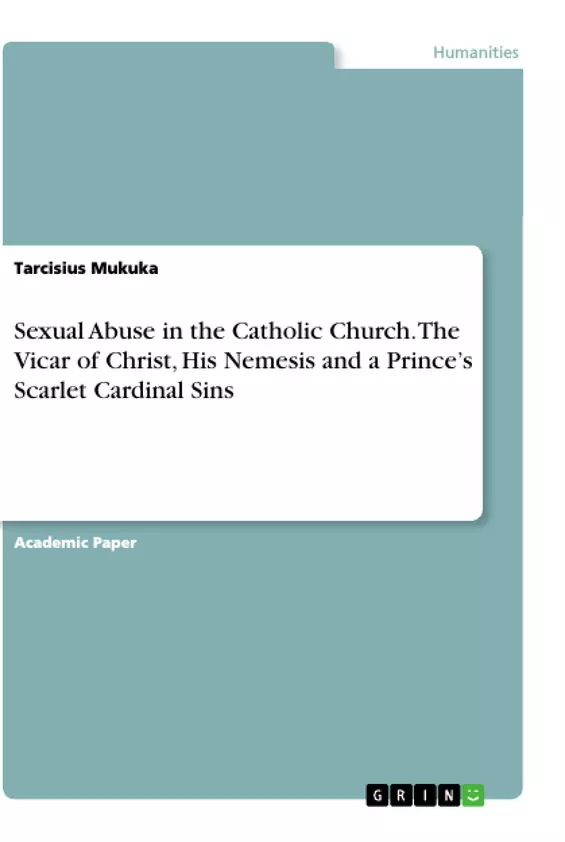Like the recent searingly honest McCarrick-Report, this paper is a no-holds barred analysis of the sexual abuse scandal generated by the high-profile former Cardinal Archbishop of Washington, Theodore McCarrick. This paper argues that the McCarrick-Report is a sign of a dysfunctional system held together by clericalism, patriarchy, secrecy, and sovereignty. Sexual abuse in the Catholic Church will not be rooted out unless the two twin villains of clericalism and patriarchy, secrecy and sovereignty are abolished.
In terms of its hierarchy, it needs to reflect the rest of society comprising male and female, straight and gay, married and celibate, young and old. This paper highlights the unprecedented nature of this report from the Secretariat of State. As John Allen says, "In the end, it’s possible the McCarrick Report may be remembered as the single most consequential step toward reform during the Francis papacy, not only because of what it reveals about this particular case, but the precedent it sets for how all future cases ought to be handled. Once the genie of transparency is out of the bottle, that is, it’s going to be awfully difficult to put it back in."
It is hoped that one of the corollaries of the McCarrick Report is to lead to a change in the way bishops are appointed in the Catholic Church. They ought to be elected by their constituency to a limited or even to a lower retirement age of 65 or whichever comes first.
Inhaltsverzeichnis (Table of Contents)
- Introduction
- Sexual Abuse in the Catholic Church...
- What is the Issue?
- What is the Problem?
- What is the Solution?
- A Pope from the Ends of the Earth with Zero-Tolerance for Sexual Abuse.
- A Renegade Papal Diplomat with a bone to chew
- A Velvet Prince of the Catholic Church...
- My Initial Shock upon Reading the Report....
- Five Takeaways from the McCarrick Report.
- A Broken and Dysfunctional System Designed to Produce Monsters...
- An All-Male and Secretly Appointed Hierarchy is no Longer Fit for Purpose
- Clericalism and Patriarchy are Part of the Problem in the Catholic Church
- Pyramidal and Absolute Monarchic Leadership in the Catholic Church……………………………….
- Vatican Secrecy and Sovereignty Shattered......
Zielsetzung und Themenschwerpunkte (Objectives and Key Themes)
This article aims to analyze the relationship between Pope Francis, Archbishop Carlo Maria Viganò, and former Cardinal Theodore Edgar McCarrick, exploring the issue of sexual abuse within the Catholic Church. It examines Pope Francis' zero-tolerance stance, the actions of a renegade papal diplomat, and the role of a high-ranking figure within the Church. The article also critically assesses the McCarrick Report and its implications for the Catholic Church.
- Sexual abuse in the Catholic Church
- Pope Francis' zero-tolerance policy
- Clericalism and patriarchy as contributing factors
- Secrecy and sovereignty as barriers to reform
- The McCarrick Report and its implications for the Church's future
Zusammenfassung der Kapitel (Chapter Summaries)
The article begins with an introduction outlining the author's perspective and highlighting the significance of the McCarrick Report. It then delves into the issue of sexual abuse in the Catholic Church, examining its prevalence, causes, and proposed solutions. The article then focuses on Pope Francis' commitment to zero-tolerance, contrasting his approach with that of Archbishop Carlo Maria Viganò, who accused Pope Francis of harboring a gay lobby within the Vatican. Chapter 5 sheds light on the actions of former Cardinal Theodore Edgar McCarrick, whose abuse scandal led to the publication of the McCarrick Report.
Chapter 7 delves into the key findings of the McCarrick Report, highlighting the dysfunctional system within the Catholic Church, the impact of clericalism and patriarchy, and the role of secrecy and sovereignty. The article concludes with a discussion on potential solutions, emphasizing the need for transparency, reform of the Church's hierarchy, and a greater focus on protection and accountability.
Schlüsselwörter (Keywords)
Sexual abuse, Catholic Church, Pope Francis, McCarrick Report, clericalism, patriarchy, secrecy, sovereignty, zero-tolerance, accountability, reform, transparency, hierarchy.
- Citar trabajo
- Dr. Tarcisius Mukuka (Autor), 2020, Sexual Abuse in the Catholic Church. The Vicar of Christ, His Nemesis and a Prince’s Scarlet Cardinal Sins, Múnich, GRIN Verlag, https://www.grin.com/document/961955



